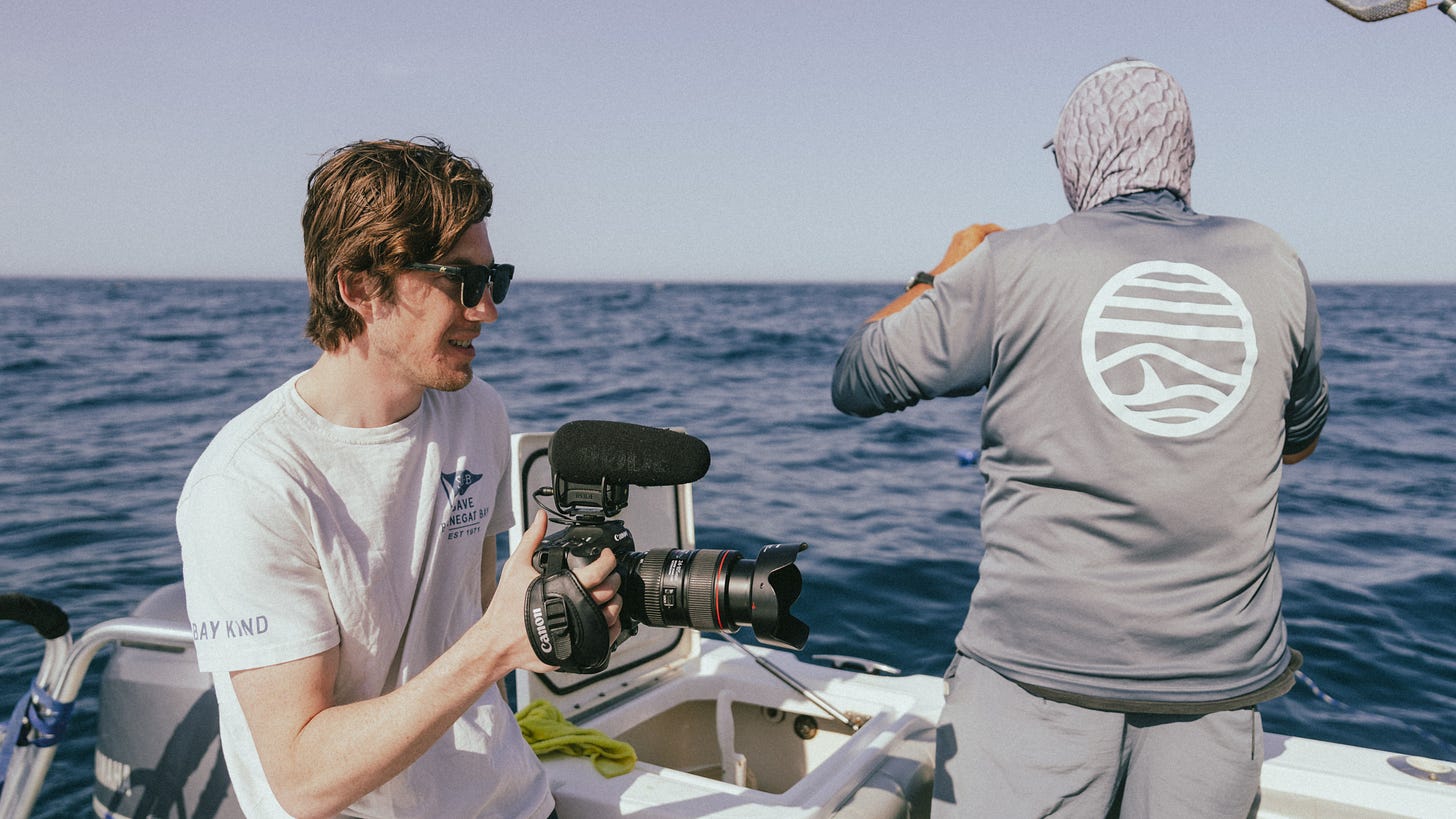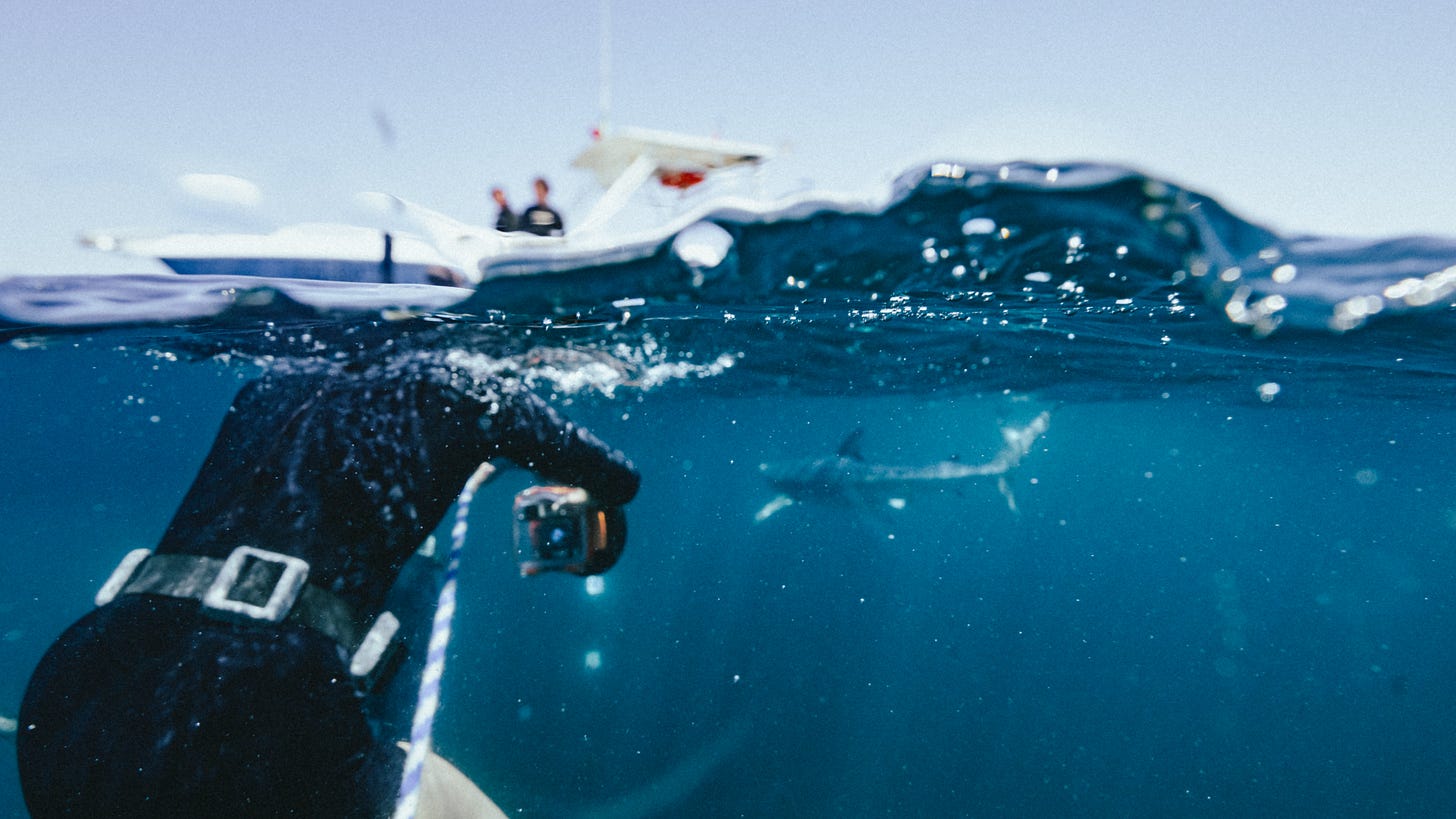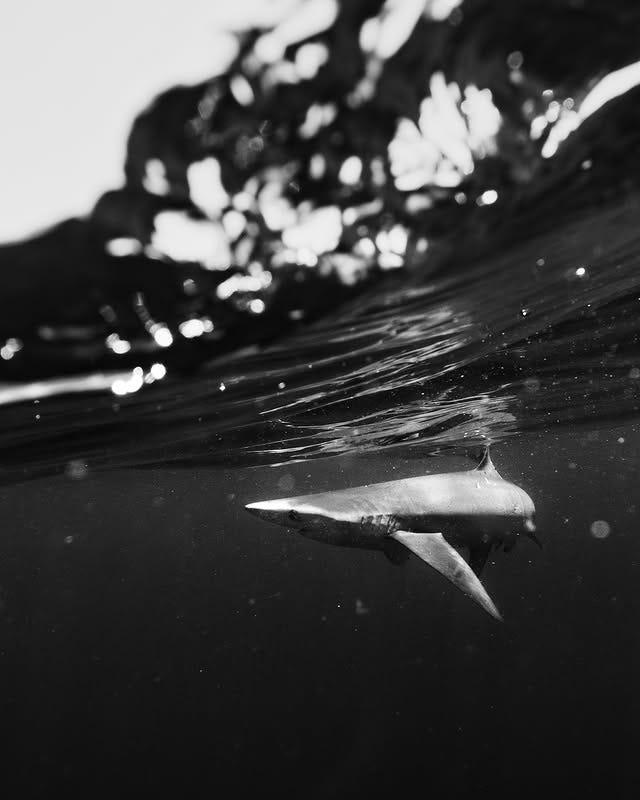Over the past two weeks, I’ve been in Baja California Sur, Mexico, working on a short documentary film that encapsulates the miraculous nature of this incredible place. During this trip, we were focused on learning more about these species and understanding the human connection to the marine wildlife in Baja California.
In last week’s installment, we talked about my time on and connection to the island of Espiritu Santo, off the coast of La Paz, Mexico. This week, in the second installment of this story, I want to share a little bit about my experience swimming with the ocean’s most famous predators.

The southern tip of the Baja Peninsula is a confluence of different worlds in more ways than one. On one hand, it’s where the waters of the Pacific and the Gulf of California collide, but it’s also the point where commercialization meets humanity’s infatuation with the incredible diversity of life in our planet’s oceans.
I’ve always been fascinated by humanity’s relationship to the ocean. In so many ways, our species is interconnected to the ocean. We depend on its creatures for our food, its waters for transportation, and its chemistry for the existence of our atmosphere. In addition, we seem utterly enamored with its existence, so much so that millions of people spend millions of dollars every year simply to sit on its shores and look out across its waves.
In Cabo, the collision between our infatuation with the ocean and its abundance of life is on full display. Fishing charters line the docks of the marina, divers share stories at the local restaurants, and countless eco-tourism operators sell the promise of incredible viewing experiences worth the price of admission.
Truthfully, though, the potential to see wildlife in this place is well worth the price of admission. In these waters, you can see Humpback Whales propelling themselves out of the water, striped marlin swimming at breakneck speeds along the surface, and some of the ocean’s most famous predators traversing miles of open water.
You don’t even have to leave the marina. Later in my stay, while taking a water taxi to dinner, I saw a humpback whale calf jump out of the water roughly 200 yards offshore.
After our documentary crew’s first few days in La Paz, we headed down south to Cabo San Lucas in search of these wildlife experiences that made this place such a global hotspot of eco-tourism and conservation. We wanted to understand what made this place so special and why it was such a confluence between nature and humanity.
To do this, we were specifically interested in joining an expedition to find one particular group of animals: sharks.
I’ve never really had a relationship with sharks. Throughout my studies in marine science and conservation, I have always found them to be fascinating creatures, but the majority of my interaction with them has been through media. To be honest, they’ve been something of a mysterious animal in my world, and I never thought I’d find myself working on a project that centers them.
The one thing about sharks that has always fascinated though, is humanity’s relationship to them. Like many other dangerous animals, our society has sought to villainize these creatures through centuries of overdramatized stories and tall tales.
I’m not immune to these stories. Like many people, I watched Shark Week when I was younger, and the second I enter open water, John Williams' iconic score starts playing in the back of my head. We’ve been indoctrinated by these stories and taught to perceive sharks as bloodthirsty, brutal, and terrifying creatures hellbent on killing.
The reality couldn’t be any further from the truth. Although sharks are dangerous and powerful predators, they are also severely misunderstood creatures.
Shark attacks around the world are incredibly rare. In 2024, there were 47 reported unprovoked attacks worldwide, the lowest total in nearly 20 years.
In contrast, the killing of sharks continues to rise. Humans are estimated to kill 100 million sharks per year. Yes, you read that right, 100 million. That’s 274,000 sharks per day. As of 2022, this harvest has led to 31 percent of sharks being considered at risk of extinction, with the main cause of their decline being overfishing.
Sharks, now more than ever, need to be seen differently. They are incredible creatures with a diversity of different species that are each critical to the functioning of our oceans.
The need for a change in the perception of these creatures is one of the main reasons we wanted to talk with some of the researchers and guides who are working to protect them through education and experience.
That’s why we connected with Latitude Encounters, a shark diving expedition crew based out of Cabo San Lucas. Through their expeditions, they take people out to freedive and snorkel with a variety of species, including pelagic (open ocean) sharks. These shark trips allow individuals to get an up-close and personal experience with these incredible creatures and form a lasting connection with them.

On the morning of our expedition, we arrived and were introduced to several of our guides for the day. For our first day, we were being guided by Fernanda Nieto, founder of Latitude Expeditions, shark diver and marine biologist Andriana Fragola, shark researcher Dr. Katy Ayres, and our boat captain, Andres Montes Rodriguez. We were joined by wildlife guide expert Mathias Van Asch on our second day.
Over the next few hours, we slowly ventured out to the open ocean, as Katy and Fernanda shared more about the process of shark diving and provided a bit more about the incredible creatures we were about to swim with.
The pelagic sharks they often seen on these expeditions are Blue Sharks and Mako Sharks, two well-known species common across the world. They are also some of the most fished species of sharks, especially Blue Sharks, which are the most commonly caught species worldwide, comprising roughly 60 percent of all catch.
After our debrief and some of the dive crews' reading of the waves, we arrived at the location the dive team felt was a good place to find some sharks, and we began our wait. For our team, there was a nervous silence over the boat as we prepared to get into the water with these famous ocean predators.
For myself, I’ve spent a lot of time in the ocean, snorkeling, swimming, and studying. Unfortunately, not a lot of that time was spent in the rolling waves of the Pacific, let alone swimming with one of the most notable marine predators on the planet.
In other words, getting into the water was a challenge. As we filtered into the ocean one by one, following our guide to the line where we would view the sharks from, the nerves got stronger and stronger. I slowly put on my weights, fins, and cleaned my mask. I closed my eyes. Deep breaths. Deep breaths.
I had to commit myself to letting go of whatever outcome was to come. I had to release myself to becoming a visitor in the shark's domain and playing by their rules.
One last deep breath. I opened my eyes and got the thumbs up from my guide. Time to go. I jumped into the water and waded into the presence of one of our planet’s most famous creatures, swimming side by side with an open ocean predator.
I will be the first to tell you, I struggled in the water. Entering the open water with these creatures in the rolling waves of the Pacific was a challenge for me. I struggled to calm my breathing and found myself getting overwhelmed by the waves.
In between those moments of struggle, though, there were moments I will never forget. Having a Blue Shark swim underneath your feet or having a Mako Shark approach you like a curious cat investigating your presence, I will never forget that feeling.
Even if it was a few mere moments, it completely transformed my relationship with these creatures. I found myself realizing they were no longer the terrifying portrayals I’d too often seen on a television screen, but living and breathing beings who were existing in this world just like any other creature. They were real. They had personalities. And they were magical.

We spent the rest of the day jumping in and out of the water with the animals, with a few of us (me) taking some prolonged breaks watching from the boat, and sharing our separate experiences with the animals. It was inspirational to see my fellow crew members having their relationships with sharks changed by the adventure.
In my experience, I was frustrated by my struggles in the water. At the time, I found myself focusing a bit too much on it.
Yet, as the days have passed, I’ve realized how enamored I am with the experience. Swimming with the sharks felt like touching something divine. It was terrifying and only lasted moments, but it was pure magic. Almost surreal.
I still can’t stop thinking about it, and I’m not sure I ever will.
I think those split seconds are at the heart of the experience, because through those tiny moments of magic, I see sharks differently. I shared space with them, and now I understand a little more about them. They are marine animals who are worthy of their international fame, not because they should be feared or loathed, but because they should be celebrated as symbols of the incredible life in our planet’s oceans.
If you are ever interested in swimming with sharks and going on a shark diving expedition in Cabo San Lucas or Baja California Sur, check out Latitude Encounters. I’d highly recommend this team; they are an incredibly knowledgeable, experienced, and are a downright fun group of passionate marine stewards.
Also, check out some more photos of the trips below, taken by our crew’s awesome wildlife filmmakers and photographers, Nate Stephens and Whitney Whitehouse.
Story of the Week
Staying on the topic of sharks, this week’s story comes from Mongabay, a non-profit publication reporting on environmental issues through a network of global environmental journalists.
In this story, Basten Gokkon reports some inspiring news out of Indonesia, the world’s largest shark fishing nation. The story shares a new conservation effort in the country that provided alternative livelihoods for participating shark fishers, bringing down Thresher Shark catch among the fishers by 91 percent.
You can read the story and learn more about these conservation efforts by checking out the article here.
NOTE: Remember to sign up for our membership community, The Naturalists, which includes access to the Monthly Challenges, community chat, events, and more. Sign up and join our Naturalist community below.
Thanks for being here, friends. See you in the next one.
With love,
Keegan








